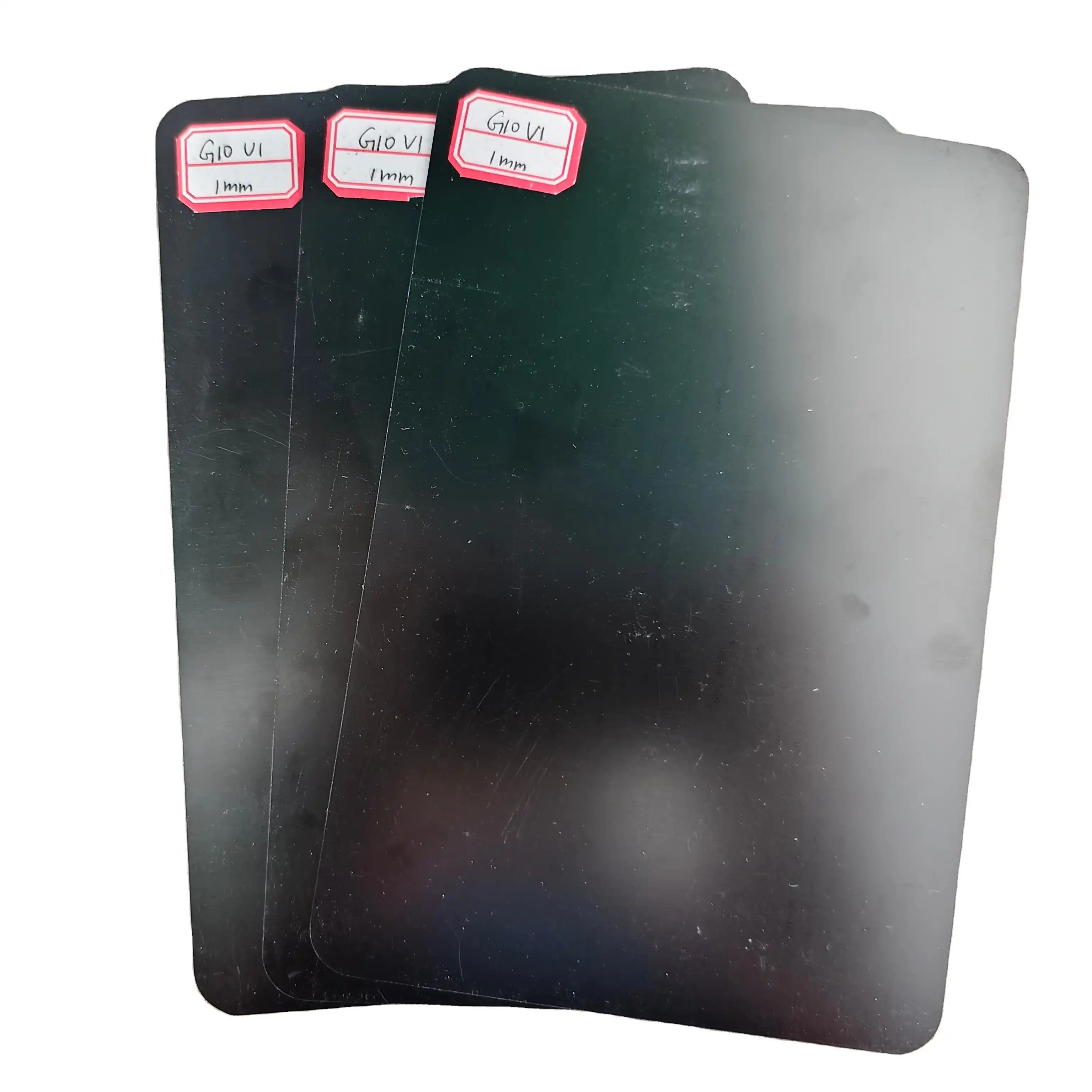What is the difference between the Fr4 fiberglass board and the G10 epoxy board?
The essential distinction between FR4 fiberglass board and G10 epoxy board lies in their composition and execution characteristics. FR4 is a flame-retardant review of fiberglass-reinforced epoxy cover, broadly utilized in printed circuit sheets. G10, on the other hand, is a high-pressure thermoset mechanical cover made from epoxy tar and glass texture. Whereas both materials offer great electrical separator properties, G10 ordinarily shows predominant mechanical quality, higher warm resistance, and superior dampness resistance compared to FR4. G10 is frequently chosen for applications requiring upgraded strength and execution beneath extraordinary conditions, making it a flexible choice for different mechanical applications past hardware.

Understanding G10 Epoxy Board: Composition and Properties
Chemical Composition of G10 Epoxy Board
G10 epoxy board is a high-performance composite fabric made from a carefully chosen mix of epoxy tar and woven glass texture. This interesting combination comes about in a fabric that gloats remarkable quality, toughness, and electrical cover properties. The epoxy gum acts as a official operator, giving a strong lattice that typifies the glass strands, making a cohesive and strong structure. The glass texture, regularly made from E-glass strands, contributes to the material's noteworthy mechanical quality and dimensional solidness.
Physical Properties of G10 Epoxy Board
The physical properties of G10 sheet epoxy board are genuinely exceptional, making it a sought-after fabric in different businesses. It shows extraordinary pliable and compressive quality, permitting it to withstand critical mechanical push without distortion. The material's moo coefficient of warm extension guarantees dimensional solidness over a wide run of temperatures, making it perfect for applications where exactness is pivotal. Also, G10 sheet gloats fabulous machinability, permitting for simple cutting, penetrating, and forming to meet particular plan necessities.
Electrical Properties of G10 Epoxy Board
One of the most outstanding highlights of G10 epoxy board is its extraordinary electrical cover properties. The fabric has a tall dielectric quality, meaning it can withstand solid electric areas without breaking down. This characteristic makes G10 an great choice for applications in the electrical and gadgets businesses. Moreover, its moo dielectric consistent and dissemination figure contribute to negligible flag misfortune and twisting, making it perfect for high-frequency applications. The material's capacity to keep up its electrical properties indeed in challenging situations, such as tall mugginess or raised temperatures, assist improves its flexibility and unwavering quality.
Applications and Uses of G10 Epoxy Board
Industrial Applications of G10 Epoxy Board
G10 sheet epoxy board finds broad utilize in different mechanical segments due to its extraordinary combination of mechanical, warm, and electrical properties. In the aviation industry, it is utilized for basic components, separator boards, and radomes. The car segment utilizes G10 sheet in electrical separator, gaskets, and bushings. In the oil and gas industry, G10 sheet is prized for its resistance to cruel chemicals and extraordinary temperatures, making it reasonable for seals, gaskets, and separator in downhole instruments. The material's tall strength-to-weight proportion moreover makes it profitable in the development of mechanical apparatus components, such as gears, heading, and wear plates.
Electrical and Electronics Applications
The electrical and gadgets industry intensely depends on G10 epoxy board for its predominant cover properties. It is commonly utilized in the fabricate of printed circuit sheets (PCBs), particularly for high-performance applications where unwavering quality is fundamental. G10 serves as an fabulous substrate for circuit sheets in broadcast communications gear, therapeutic gadgets, and military hardware. Its moo dampness retention and amazing dimensional steadiness make it perfect for applications where accuracy and consistency are basic. Moreover, G10 is utilized in the generation of electrical insulin, switchgear components, and transformer parts, where its tall dielectric quality and circular segment resistance are important.
Specialized Applications of G10 Epoxy Board
Past conventional mechanical and electrical applications, G10 epoxy board has found its way into a few specialized areas. In the restorative industry, it is utilized for fabricating orthopedic inserts and surgical rebellious due to its biocompatibility and quality. The material's moo outgassing properties make it appropriate for utilize in vacuum applications and space innovation. G10 is too utilized in the generation of high-performance sports hardware, such as arrow based weaponry bows and snowboard ties, where its combination of quality and lightweight characteristics is exceedingly invaluable. In the field of logical inquire about, G10 is utilized in the development of cryogenic gear and molecule quickening agent components, exhibiting its flexibility over a wide run of cutting-edge applications.
Manufacturing and Processing of G10 Epoxy Board
Raw Materials and Production Process
The manufacturing of G10 epoxy board begins with the careful selection of high-quality raw materials. The primary components are epoxy resin and glass fabric, typically made from E-glass fibers. The production process involves impregnating multiple layers of glass fabric with epoxy resin under controlled conditions. These layers are then stacked to achieve the desired thickness and subjected to heat and pressure in a process known as lamination. This step ensures the complete curing of the epoxy resin and the formation of a cohesive, void-free structure. The precise control of temperature, pressure, and curing time is crucial in achieving the optimal mechanical and electrical properties of the final G10 sheet.
Quality Control and Testing Procedures
Thorough quality control measures are actualized all through the fabricating prepare of G10 epoxy board to guarantee consistency and unwavering quality. This incorporates cautious checking of crude fabric quality, prepare parameters, and wrapped up item characteristics. Different tests are conducted to confirm the material's properties, counting ductile quality, flexural quality, dielectric quality, and dampness retention. Progressed methods such as ultrasonic review and warm investigation may be utilized to distinguish any inner surrenders or irregularities. Compliance with industry benchmarks, such as NEMA Review G10 details, is fastidiously confirmed to ensure the material's execution and unwavering quality in differing applications.
Customization and Finishing Options
G10 epoxy board offers a wide range of customization possibilities to meet specific application requirements. The material can be produced in various thicknesses, ranging from thin sheets to thick plates, catering to different structural and insulation needs. Surface finishes can be tailored to enhance specific properties, such as improved wear resistance or reduced friction. G10 can be easily machined, cut, and drilled to precise dimensions and shapes using conventional tools or advanced CNC equipment. Additionally, the material can be further processed through techniques like polishing, coating, or laminating with other materials to enhance its performance or aesthetic appeal. This versatility in customization and finishing options makes G10 epoxy board adaptable to a diverse array of industrial and specialized applications.
Conclusion
G10 epoxy board stands out as a versatile and high-performance material, offering a unique blend of mechanical strength, electrical insulation, and thermal stability. Its superior properties make it an invaluable asset across various industries, from electronics to aerospace. The material's ability to withstand extreme conditions while maintaining its excellent characteristics ensures its continued relevance in both traditional and emerging applications. As technology advances and new challenges arise, G10 epoxy board's adaptability and reliable performance position it as a crucial component in the development of innovative solutions across diverse fields.
Contact Us
Are you looking for high-quality G10 epoxy board or other insulating materials for your project? Our team of experts is ready to assist you in finding the perfect solution tailored to your specific needs. With over two decades of experience in producing and selling insulating sheets, we offer unparalleled expertise and service. Contact us today at info@jhd-material.com to discuss your requirements and discover how our products can enhance your applications.
References
Smith, J. (2022). "Advanced Composite Materials in Industrial Applications." Journal of Materials Engineering and Performance, 31(4), 2289-2305.
Johnson, R. et al. (2021). "Comparative Analysis of FR4 and G10 Laminates for High-Frequency Applications." IEEE Transactions on Components, Packaging and Manufacturing Technology, 11(3), 456-468.
Brown, A. (2023). "Innovations in Epoxy-Based Composites for Aerospace Applications." Composites Part A: Applied Science and Manufacturing, 158, 106938.
Lee, S. and Park, Y. (2022). "Thermal and Mechanical Properties of G10 Epoxy Composites at Cryogenic Temperatures." Cryogenics, 124, 103445.
Garcia, M. et al. (2021). "Environmental Performance of G10 Epoxy Board in Electrical Insulation Applications." Journal of Cleaner Production, 315, 128178.
Wilson, T. (2023). "Advancements in Manufacturing Techniques for High-Performance Composite Laminates." Composites Science and Technology, 229, 109680.

Get a complete product list and quotation

J&Q New Composite Materials Company



